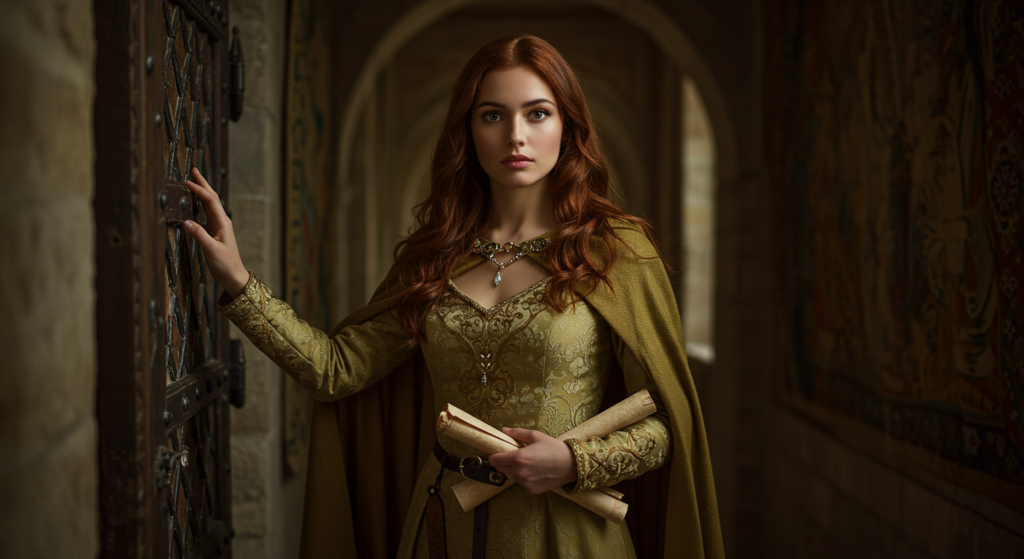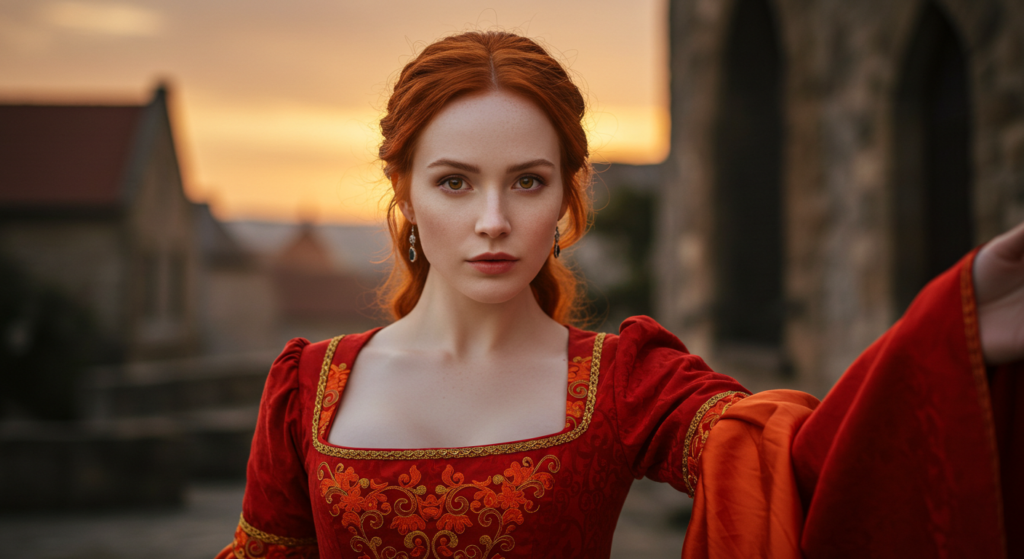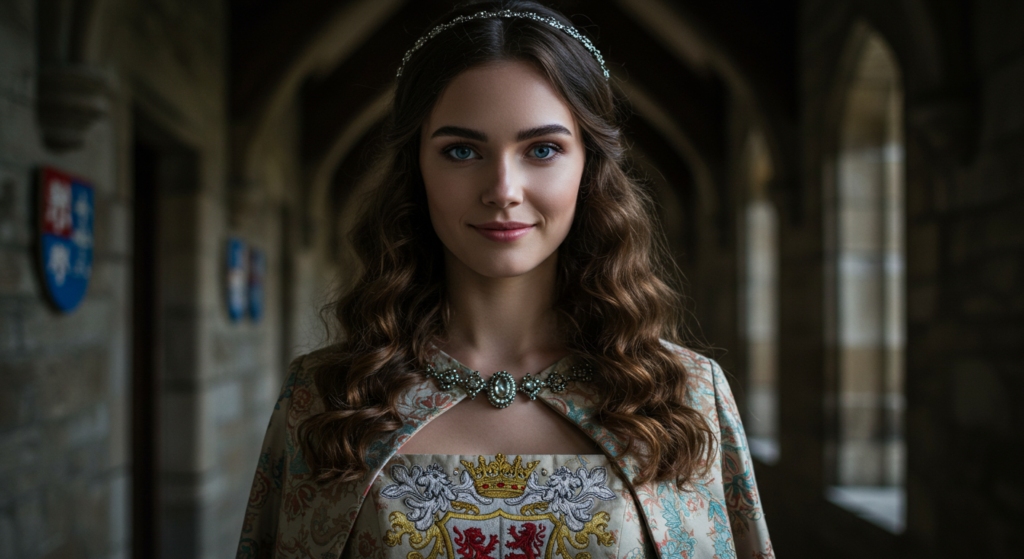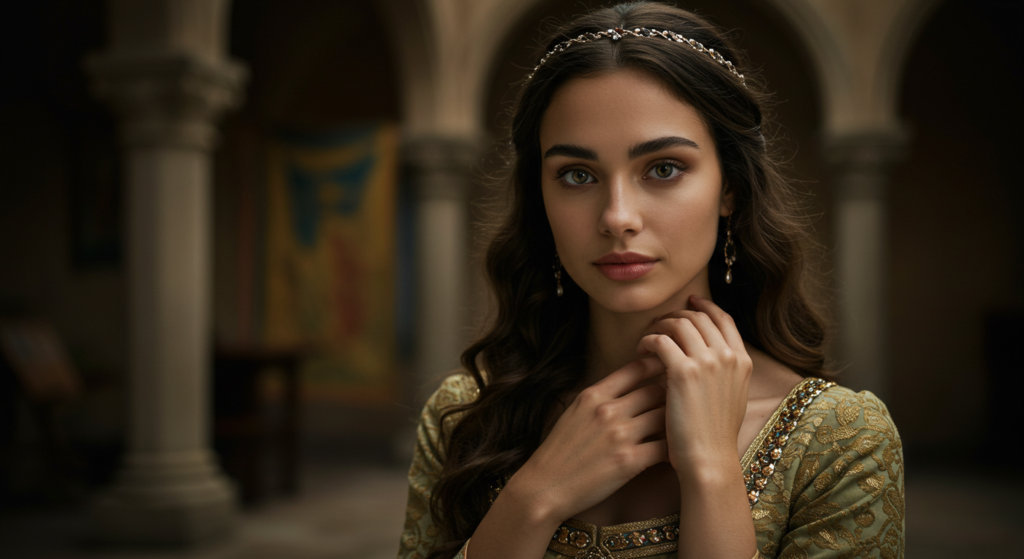Key Takeaways
- Medieval tapestries showcase rich dyes made from plants, insects, and minerals.
- These vibrant hues influenced garments for nobles and common folks alike.
- Mixing modern outfits with tapestry-inspired colors can spice up a dull wardrobe.
- Basic weaving methods from medieval times still echo in today’s decorative pieces.
- Folk motifs and heraldic designs remain a playful way to add drama to present-day fashion.

I once saw a tapestry in a friend’s hallway. Its gold threads sparkled, and the blues looked so deep, I almost believed the scene was real.
That moment taught me how intense old-fashioned colors can capture our attention. Medieval tapestries were not just pretty wall-hangings; they told stories, boasted status, and shaped clothing trends.
Are you wondering why these medieval hues still matter for modern style? Maybe you’re curious how we can borrow from these tapestries without dressing like a knight at dinner.
In this article, we’ll discover the historical roots of those colors, what made them special, and how to blend them into current outfits. Let’s explore weaving secrets, unexpected color combos, and design notes that remain relevant now.
We’ll also ask weird questions that might pop up about medieval dyes, weaving constraints, and how folks kept these cloths so bright.
Our journey will include mini-lists, a few data tidbits, and fun sub-sections. Then, by the end, you’ll have a full bag of tips for merging medieval tapestry hues into your closet. Let’s dive in.
1. The Fabric Of Medieval Color

Early Dye Sources
Wool, linen, and silk formed the basic materials for medieval tapestry creation. Many artisans used onion skins, madder roots, or crushed bugs to form striking colorants. Who would guess that a small insect could make such a bold red? For instance, cochineal gave a deep crimson that stuck around for ages.
Why did they bother with these odd sources? The medieval economy didn’t offer synthetic dyes, so craftspeople turned to nature. They tried leaves, bark, and metal for different shades. Did they smell funky sometimes? Yes, they did. But the results were brilliant.
Weaving Magic
As threads left the loom, skilled hands guided them into elaborate scenes. This weaving method used different color yarns inserted by hand to form images. Picture a painter applying bits of color one brushstroke at a time. That’s how tapestry weavers worked, only with yarn and patience.
Many tapestries depicted lively hunts or epic battles. The chosen hues had to pop on large walls. Vibrant reds, bright blues, and warm golds told the viewer, “This place is fancy.” And sometimes, these tapestries said, “We can afford expensive dyes, so we must be important.”
Influence On Fashion Silhouettes
Have you seen how drapes might affect modern clothing shapes? Medieval folks liked long, flowing garments. Tapestries often showed belted tunics or layered gowns. Individuals in a castle might glance at a tapestry, see some noble wearing a wine-toned robe, and think, “I want one just like that.”
Colors in tapestries also guided accessorizing. A bright green under-tunic might match a cloak lined with gold trim. Over time, these bold combos became a style statement for royals. Common folks sometimes tried cheaper versions, maybe with duller dyes, but they aimed for a similar flair.
2. Royal Blues And Courtly Purples

Rare Purple Pigments
In the Middle Ages, purple often signaled top-tier status. How come? Purple dye came from certain seashells, and it took loads of them to produce a single garment. That process was time-consuming. Because of that, wearing purple conveyed wealth. Some people might think that was silly, but others found it downright glamorous.
Tapestry art needed only bits of purple thread to stand out. Weavers saved that precious color for borders or special motifs. Even a small patch of purple in your wall-hanging meant you had funds. In turn, individuals who saw that shade in tapestries thought, “If I add a dash of purple to my cloak, I’ll look like a big shot.”
Blue: More Than Just Indigo
Blue was another elite color. Sometimes, folks used woad or indigo for bright blues. But top-quality blues came from rare sources, which cost major coin. When tapestries showed brilliant azure skies, everyone knew it wasn’t a cheap job.
Does it matter today if we use cheap or pricey dyes for our clothes? Not in the same way. But these blues remain popular. People still connect them with grandeur or regal vibes. That’s why a deep cobalt sweater can feel extra special.
Mixing Purple And Blue In Outfits
If you see a medieval tapestry with swirling purple vines next to a sapphire background, you might think that’s too loud. But many modern stylists suggest pairing deep purple with navy for an elegant take. Try a navy skirt and a purple top. Or a royal-blue jacket with a plum scarf. The key is balancing bold hues with subdued accents, maybe neutral shoes or gold earrings.
A question might arise: “Do I look like I stepped out of a theme park?” Possibly not. You can tone it down with simpler lines. Or toss in a white undershirt to break up the color block. You’ll keep the medieval flair without scaring your coworkers.
3. Earthy Greens And Rusty Browns

Green Dyes From Everyday Plants
Green was linked to nature. People extracted color from herbs like weld or mixing woad with other plant-based dyes. This gave lively greens for tapestry scenes with fields, forests, or foliage motifs. The average villager saw these tapestries and wanted a hint of that vibrant green on a tunic or skirt.
Sometimes, the green turned out a bit dull, so weavers learned to over-dye fabrics. They used one dye bath for yellow, then a second for blue, merging them into green. A few green garments faded fast, so tapestry artisans tried to ensure stable color with mordants (like iron or alum).
Brown Undertones And Rustic Appeal
Brown might not sound exciting. In medieval tapestries, though, browns anchored the scene: tree trunks, ground, wooden beams in castles. This earthy tone set the stage for flashy colors. Browns also clothed peasants in many scenes.
In modern closets, browns can pair with bright reds or greens in a tapestry-inspired palette. A brown coat with green accessories can echo that medieval, earthy vibe. Maybe you’ll slip into a chocolate-brown sweater with a bold belt to lighten it up. That might reflect a tapestry’s overall warmth.
Green-Brown Harmony
If you’re worried about looking like a forest elf, break up green and brown with a neutral piece. Or add metallic touches. Picture a belt buckle or a subtle chain. The medieval world enjoyed metals, especially gold or iron details. By weaving in gold jewelry, you highlight the tapestry-like blend of earth tones with a bit of sparkle.
Another question: “Will I look overdressed at the grocery store?” Probably not. As long as you keep the silhouette casual, these colors can feel quite grounded and modern.
4. Bold Reds And Fiery Oranges

Sourcing Vibrant Reds
Red dyes often came from madder roots or cochineal bugs. Medieval tapestry weavers understood that red grabs the eye. It symbolized power or bravery in many scenes. So, a tapestry with a strong red backdrop told visitors, “This hall belongs to someone confident.”
Imagine wearing a bright red cloak in that era. You would stand out at feasts or ceremonies. Even a small red sash made a statement.
Orange Highlights In Battle Scenes
Orange might appear less often, but we do see it in scenes of sunsets, fire, or dramatic details. Some artisans mixed red and yellow sources to get orange. This color could represent energy. Tapestry borders used orange to highlight transitions, like from one panel to another.
Modern folks sometimes fear orange. But used well, it can spark interest. A corner of your outfit—maybe a scarf or belt—can bring a bit of that tapestry brightness into your everyday look.
Red-Orange Combos For Today
Should you wear bright red with bright orange? That might be too intense for some. But you can pick a darker red, like burgundy, and pair it with a pumpkin-orange accent. Or try a red blazer with a muted orange-brown pant. You’ll get an echo of that medieval tapestry glow without feeling like you’re wearing a neon sign.
Sometimes I get paranoid about pairing warm colors. But if you remember those medieval scenes, they loved big drama. Why not let your outfit reflect that, at least a little? If you’re shy, keep the rest neutral—maybe black shoes and a white shirt.
5. Gold Threads And Metallic Details

The Glow Of Metallic Threads
People in medieval times adored gold. Tapestries often used real metal threads for highlights, especially around crowns or fancy borders. That shimmer gave the piece a three-dimensional effect. When candlelight hit those threads, it almost danced.
You can add metallic touches to modern outfits without going full disco. Think about gold buttons on a coat, a metallic headband, or gold-stitched embroidery on a blouse. Even a single gold necklace can mimic that tapestry glow.
Symbol Of Wealth And Prestige
Gold was expensive to produce. Weavers had to flatten real metal into thin strips and wrap them around silk or linen thread. Only wealthy patrons could pay for that. So a tapestry glimmering with gold told visitors, “We have the cash to show off.”
Today, we might not brag the same way. Still, a gold accent can elevate your style. Pair a gold-threaded jacket with jeans if you want to keep it casual. Or throw on a golden statement piece for a fancy dinner.
Creating Balance With Metallics
A big question is: “Will gold be too flashy?” It can be if you wear it head-to-toe. But a measured approach works. Try a small gold-embroidered patch on a denim jacket. Or put gold piping on the edges of a blouse. Balance that glow with subdued fabrics. Tapestries did this by surrounding gold threads with solid background colors.
For instance, gold-laced patterns on a midnight-blue base looked regal in medieval halls. You can replicate that by choosing a navy dress and gold belt. Or a black sweater with a metallic scarf. The tapestry approach is about contrast.
6. Heraldic Motifs And Symbolic Hues

Crests And Coat-Of-Arms
Medieval tapestries often featured heraldic symbols. Lions, eagles, fleur-de-lis, or swords might appear. These symbols were usually shown in bold colors: red, blue, gold, or green. This let viewers spot a family’s crest from across the hall.
Ever wonder how that ties to modern dressing? If you like strong graphic designs, you can adapt those heraldic motifs. Maybe pick a shirt with a lion emblem or a shield-like patch. It adds a hint of medieval flair without going full costume.
Symbolic Use Of Colors
Tapestry designers used color to identify friend or foe in a hunting scene. A deer might be depicted in a certain hue to align with a noble house. Or the huntsmen wore matching coats. This color coding told the story, so watchers could follow along.
In your own style, you can pick certain colors to represent your personal vibe. Some folks adopt a signature color and run with it. Or you could mix two or three colors that you love, similar to how coats-of-arms did. This approach ties your wardrobe together.
Modern Heraldic Fashion
Don’t worry that you’ll look silly. A small embroidered patch on a blazer or a bold printed T-shirt with medieval crest details can be fun. If someone asks, “Why the weird lion on your shirt?” you can say, “I’m channeling old tapestry vibes.” That’s an interesting conversation starter.
To keep it subtle, go for smaller motifs or tone down the color. You could also place the crest on a purse or accessory. Medieval tapestries used these symbols as a visual signature. Let that idea guide you, but in a way that feels authentic.
7. Incorporating Medieval Hues Into Modern Wardrobes

Accessorizing With Tapestry-Inspired Pieces
One simple approach: get accessories that echo tapestry colors. A deep red scarf, a cobalt blue bag, or a gold-toned belt can transform an everyday outfit. If you fear bright color, start small. Maybe you add a patterned headband that features a tapestry motif.
Belts embroidered with swirling vines or stylized animals can hint at medieval artistry. Pair that belt with jeans and a plain tee to let the accessory pop. If you want more drama, layer multiple tapestry-inspired pieces. But watch out for clashing patterns. Tapestries can be busy, so in modern wear, fewer patterns might be better.
Bold Layering Tips
How do you stack layers without looking bulky? Medieval folks wore tunics, cloaks, and robes. You can interpret that with modern layering. Wear a long cardigan in a soft brown or deep green, then top it with a short jacket in a contrasting hue. Add a statement belt or scarf in a tapestry color.
Is that too complicated for daily life? Possibly. But for cooler months, layering is practical. A green turtleneck under a navy blazer might nod to medieval color combos. Let your imagination roam, but keep it comfortable.
Subtle Prints And Embroidery
If full tapestry prints seem overwhelming, consider small embroidered details on sleeves or collars. Look for garments that feature medieval-like vines, floral shapes, or heraldic motifs. You don’t have to wear an entire tapestry. Tiny patches or gentle patterns can capture that old-world charm.
This subtle approach suits folks who want a refined style. A black dress with gold embroidered cuffs can remind you of a tapestry border. It’s elegant, easy to style, and not too flashy.
8. Preservation And Modern Reinterpretations

Caring For Authentic Pieces
Real medieval tapestries are fragile. Light, moisture, and pests can damage fibers. Museums typically keep them in controlled environments. They regulate temperature and humidity to protect dyes. Why does this matter for fashion lovers? Because the lessons learned in preserving tapestries—like protecting fabric from sunlight—can help us prolong the life of our own clothes.
If you own vintage or tapestry-style garments, store them in breathable garment bags. Keep them away from direct sunlight. Moths can munch on wool, so lavender sachets or cedar blocks may help. This approach ensures your carefully chosen tapestry-inspired items last longer.
Contemporary Tapestry Art
Artists still create tapestries. Some draw upon medieval hues but add modern twists, such as abstract shapes or pop-culture references. If you want a statement piece in your home, you could pick a contemporary tapestry that merges old dye colors with modern design. That can spark style ideas for your wardrobe.
If you see a new tapestry featuring bold red outlines and a deep blue background, you might adapt that color combination for your next outfit. Even if you never weave a thread, these visuals can inspire fresh approaches to layering and color blocking.
Bridging Past And Present
Does medieval tapestry style seem old-fashioned? It can, if you go all in with floor-length robes and heavy embroidery. But the real magic is in taking small elements—like a color palette, a metallic accent, or a stylized crest—and applying them in fresh ways.
You might ask, “How do I not look like I stepped out of a historical fair?” Focus on modern silhouettes. Then inject tapestry-inspired hues, patterns, or accessories. Keep the lines simple, the color combos bold, and let the medieval spirit shine through.
Conclusion

Medieval tapestry hues still spark interest today. They remind us that color can tell stories, convey status, and bring life to textiles.
Whether you’re drawn to deep reds, regal purples, or shimmering gold threads, you can blend these historical inspirations into everyday wear. Each shade weaves a narrative of craft, tradition, and creative expression.
And if you ever catch yourself thinking, “This color is too loud,” remember that medieval artisans loved drama.
They let bold shades do the talking. Don’t be scared to bring a bit of that flair into your life. Tapestry-inspired fashion stands out, but it can also feel incredibly personal and fun.
Summary Table

| Color/Element | Medieval Source | Modern Use |
|---|---|---|
| Purple | Seashell-based dye | Accent scarves, regal dresses |
| Blue | Woad, indigo, rare pigments | Jackets, skirts, or denim-based outfits |
| Green & Brown | Plant-based dyes, over-dyeing | Earthy layering pieces or subtle accessories |
| Red & Orange | Madder root, cochineal, combos | Statement coats, bold belts, small pops of color |
| Gold Threads | Real metal flattened into yarn | Metallic details on collars, bags, or footwear |
| Heraldic Motifs | Family crests, bold symbols | Small patches on tees, embroidered jackets |
FAQ

1. Can I wear a tapestry pattern without looking like my grandma’s curtains?
Yes. Pick one main tapestry-patterned piece—like a skirt—and keep the rest simple. Add a modern top in a neutral color, and you’ll look stylish, not frumpy.
2. Are these medieval dyes still used today?
Some are. Natural dyes like madder root, indigo, and cochineal remain popular for artisan fabrics. But most mass-produced clothing uses synthetic dyes. You can still find natural-dyed items if you look for niche brands.
3. Will medieval-inspired colors clash with my usual black-and-white wardrobe?
Not if you introduce them gradually. A muted tapestry-inspired scarf or a single jewelry piece can add depth to monochrome outfits without overwhelming your style.
4. Is it possible to incorporate metallic details for casual daytime looks?
Yes, in small doses. Look for clothes with subtle gold or silver stitching on pockets or cuffs. A metallic belt buckle can also bring a low-key shine to denim outfits.
5. Where can I find medieval tapestry-style items?
Try vintage stores, craft fairs, or smaller labels that focus on embroidery and woven textiles. You might also spot tapestry-patterned accessories in mainstream retailers, especially in fall or winter collections.
6. Does all this layering work in warmer climates?
It can. Swap heavy fabrics for lighter ones. A linen jacket embroidered with medieval-like details can replicate tapestry vibes without making you sweat. Always adapt the material to your region’s weather.
7. What if people think I look eccentric in medieval hues?
If it makes you happy, roll with it. Or tone it down with modern silhouettes and just a hint of medieval color in your accessories. That way, you retain the charm without stepping out in full costume.
8. How do I keep tapestry-patterned clothes clean?
Read the care label. If it’s a delicate fabric, hand-wash or dry-clean to preserve the dyes. Avoid harsh chemicals. Keep them out of direct sunlight to prevent fading over time. A little care goes a long way.

Neha Z. is not just any writer; she’s a storyteller who has graced the online world with her evocative prose for over half a decade. Venturing into the intricate nuances of women’s lives, she weaves stories that range from life’s highs and lows to the multifaceted essence of femininity. Each piece she pens radiates sincerity and artistry. As you delve into Neha’s musings, you’ll find reflections that echo your own journey and insights that inspire. Immerse yourself in her world, and let her stories touch your heart.
Reviewed By: Joanna Perez and Anna West
Edited By: Lenny Terra
Fact Checked By: Matthew Mansour
Photos Taken or Curated By: Matthew Mansour
